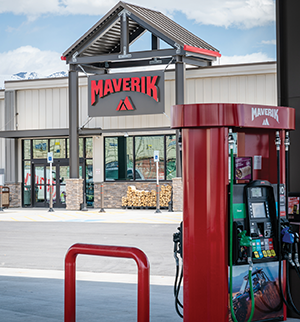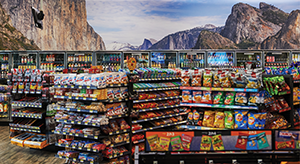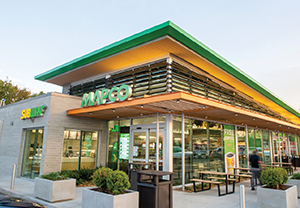The shopper experience has always been important, but in the age of omnichannel commerce, creating a connection that resonates with today’s consumers is more challenging than ever. While it’s true that retailers need to reach consumers through digital channels, brick-and-mortar stores are still relevant, and retailers with a laser focus on an exceptional in-store shopping experience may have an edge over their competitors.
Changes don’t have to come in monumental programs or packages.
Understanding how design and ambience connect with customers offers a good starting point for how consumers experience your brand. “In the decision on where to shop, the experience now comes into play,” said Lori Mukoyama, NCIDQ, IIDA, LEED GA, design principal at Gensler, an architecture, design and planning firm.
Two convenience retailers creating conscious connections with customers through design include Maverik and MAPCO. Both chains convey brand imaging through design. For Maverik it’s a continuation of a legacy approach to design, while MAPCO’s new flagship store brings with it a more modern design that works to elevate the brand’s image.
MAVERIK DEEPENS CONNECTION POINTS
 The design approach of Maverik—Adventure’s First Stop continues to pull customers into an immersive experience with graphics that create connections to the brand’s inherent messaging of fueling adventure. How the nearly 400-store chain tackles that graphics program has evolved over the years, said Sarah Kovac, director of architecture and engineering for Maverik. “Previously we had a one-size-fits-all graphics program that didn’t change based on region. We’ve updated that to store-specific regions and now create experiences that our guests can connect with.”
The design approach of Maverik—Adventure’s First Stop continues to pull customers into an immersive experience with graphics that create connections to the brand’s inherent messaging of fueling adventure. How the nearly 400-store chain tackles that graphics program has evolved over the years, said Sarah Kovac, director of architecture and engineering for Maverik. “Previously we had a one-size-fits-all graphics program that didn’t change based on region. We’ve updated that to store-specific regions and now create experiences that our guests can connect with.”
Customers see images of places they likely frequent if they live nearby or a location they just visited if they are traveling through the state. Images at the Oroville, California, store that opened in October 2021, for example, are all unique to California. In-house photographers take all the images, and stores include topographic maps specific to each state. The Oroville store closely resembles a North Salt Lake City, Utah, store built prior to that one in 2020.
“We love adventure; we want everyone to have an adventure—whether it be in the physical world, digital sphere or just an aspirational adventure,” said Joey Hobson, vice president of marketing at Maverik. “Panoramic imagery in the store helps that. We spend a significant amount of time providing the adventure atmosphere in our stores; it’s critically important to our customers and our brand.”
If you are in the c-store business today, you are in the food business, and that’s relevant to the design and experience.
The imagery also creates connections between customers and staff, Hobson added. Customers talk to store crew members about their own experiences, for example sharing that they went on a hike in an area they might spot in store photographs. “It’s an entry point into that relationship,” he said.
Newer Maverik stores feature a new lighting package that highlights the graphics and helps create a more open feel, Kovac said, and it reflects the retailer’s latest design standard. The retailer follows set design standards and adjusts based on store size, which can range from 3,000 square feet to just under 9,000 square feet if a quick-service restaurant is included. While the chain’s proprietary BonFire food, made fresh at every Maverik every day, concept is the Maverik standard, two locations include a Dairy Queen—the first came via acquisition, while the second was a ground-up build in Elwood, Utah, in 2021.
“From a look and feel standpoint, the stores are all the same,” Kovac said, adding that Maverik is currently going through a remodel to update branding and finishings chainwide. Woodgrain finishes add to the outdoor visual, along with ceilings painted light blue to mimic the sky. Skylights bring in natural light, adding to the idea of bringing the outdoors in. Some 3D elements extend the idea further, such as artificial trees built into the architecture.
 In terms of store layout, the remodel includes repositing aisles to be straight. “We have gone back and forth with aisles— straight, then at an angle and now straight again,” she said. The straight aisles allow the retailer to pick up extra SKUs, she said and do not negatively affect shopability.
In terms of store layout, the remodel includes repositing aisles to be straight. “We have gone back and forth with aisles— straight, then at an angle and now straight again,” she said. The straight aisles allow the retailer to pick up extra SKUs, she said and do not negatively affect shopability.
Over the years, c-store design has become more elevated, with a higher expectation in general, Kovac believes, and food has played a role in that. “Food is becoming more of a focus and the norm,” she said. “If you are in the c-store business today, you are in the food business, and that’s relevant to the design and experience.”
Over the years, c-store design has become more elevated.
At Maverik that foodservice experience is the BonFire Grill, the retailer’s made-to-order concept that has grown to become a larger component of the store offering, prominently featured in select Maverik locations. Now with an open kitchen approach and more square footage dedicated to both front-of-house and back-of-house foodservice, food is a focal point visually as well as operationally. “We create a branding experience for food with red canopy signage and a similar branding approach [to the Adventure theme] with graphics to create an eye-dropping experience,” Kovac said. “It signals a different experience to the guest than grabbing an item from the cold case, which they can still opt to do if they want. BonFire includes a bit more theater; there is a trust you gain from customers by showing what you are doing.”
Kovac draws inspiration from looking at adjacent industries to the convenience store channel. As the c-store industry has evolved, a lot of the same trends seen in the general retail sector now come into play for c-stores, she noted, including experiential design and taking design cues from nature.
Hobson agrees, adding that the Maverik team is always looking at different retail formats from both a construction and design point of view. “We want to remain relevant and on the leading edge. Changes don’t have to come in monumental ways. They can be small and subtle,” he said.
 SOMETHING DIFFERENT AT MAPCO
SOMETHING DIFFERENT AT MAPCO
With MAPCO’s flagship store, the company “set out to build something different,” said MAPCO CFO Keith Slater. Located in Nashville, Tennessee, the 5,600-square-foot store features an elevated design that showcases a more modern style of architecture with wide open spaces throughout the interior and plenty of natural light.
Noticeable elements that differentiate the store include taller ceilings, floor-to-roof glass on the front of the building and clean lines overall. The store reflects the “quality and experience we will continue to create for customers in the future,” Slater said. Custom murals with outdoor cues and greenery contribute to the natural ambiance.
Customers are greeted with wide open spaces from the moment they walk into the store, with higher ceiling heights adding to the feeling of openness. From a traffic-flow standpoint, when customers enter the store, they see the large coffee island first, with a Subway quick-service restaurant sitting adjacent to that. An expanded cold vault offering, complete with a beer cave and visible from the entry point, consumes much of the back of the store. MAPCO worked with design firm Chute Gerdeman on the flagship store, which earned a design award from Shop! Association.
Customers are greeted with wide open spaces from the moment they walk into the store.
The design team was very cognizant of sightlines in the store, Slater noted. “When you go too high [with gondolas], it impacts the openness. We kept everything low so the sightlines would allow for a better feel of the store,” he said.
Seating options extend from the inside out, and indoor seating includes space for customers to linger and take advantage of wireless charging. “We tried to provide the exact experience for each customers’ expectation,” Slater said. “Customers can enjoy the store at their own pace.” The goal is to present customers choices in how they want to use the store, he added, which could mean different things to each person at different times of the day, from someone who wants to use the space to work or someone who wants to quickly grab items and go.
 Outside, a curved canopy over the forecourt additionally contributes to the more modern store aesthetic. The canopy is unique in terms of how it presents itself equally well on two different highways, Slater said, describing it as a boomerang shape. “The canopy itself is a little thinner than a traditional canopy. We didn’t want to hide the store. It works to leverage the traffic from both highways,” he added, “and presents the store from every angle.”
Outside, a curved canopy over the forecourt additionally contributes to the more modern store aesthetic. The canopy is unique in terms of how it presents itself equally well on two different highways, Slater said, describing it as a boomerang shape. “The canopy itself is a little thinner than a traditional canopy. We didn’t want to hide the store. It works to leverage the traffic from both highways,” he added, “and presents the store from every angle.”
The curved canopy will be part of future stores where there’s enough space to accommodate that design, Slater said. That includes a new build location slated for construction later this year. The flagship store, which opened in October 2021, will continue to inspire new MAPCO sites, Slater said, with the same finishes and design incorporated in refreshed and remodeled legacy stores. “The flagship store sets the standard,” he added. MAPCO currently owns 340 corporate stores.
Take Note: 4 Retail Design Trends
Want a little inspiration? Or, better yet, aspirational design-influenced goals? Looking beyond c-store design trends to examine how others are pushing boundaries can offer a new perspective. Here, Lori Mukoyama, NCIDQ, IIDA, LEED GA, design principal at Gensler, offers a view of four broader retail trends gaining traction:
1. New Levels of Connections
When it comes to shopping experiences, consumers have a desire to connect to their favorite brands in ever-evolving ways. For instance, Mukoyama noted high-end clothing store lululemon offers location-specific screen prints at certain stores that can turn a purchase into an experience with a simple “aloha” added to the brand’s merchandise. In a similar vein, the Starbucks Reserve Roastery in Chicago becomes a bit of a tourist-like experience, complete with merchandise only available at those locations.
2. A Curated Experience
Larger retail stores are using storytelling more than ever to plan stores differently. For instance, maybe the entire department store is no longer visually quite as open when customers first enter. Instead, for example, metal arches might help define a smaller area, said Mukoyama, which would then open up to a larger department. “We’re planning stores differently,” she noted, “compressing and expanding different areas throughout a larger space.”
3. Bleeding Lines
More than blurring retail lines, today’s iteration is more of a bleeding of the lines. For example, where IKEA houses a restaurant inside its stores, another omnichannel retailer entering the brick-and-mortar space is creating a crossover between food and retail, Mukoyama said. What does that look like? “More integrated,” she said, “where customers are encouraged to pick up beverages and food and take it with them as they shop.” It creates yet another different kind of experience, she said.
4. More Color, More Greenery
Color is making a comeback, said Mukoyama, specifically warm colors with deep tones and cranberry hues. “Colors that speak to our souls,” she described it, noting the aesthetic is less about a sterile, perfectionist look. Any kind of greenery, including fake foliage, has become ultra-popular as well. “It’s about having that flow from the inside out,” she said.